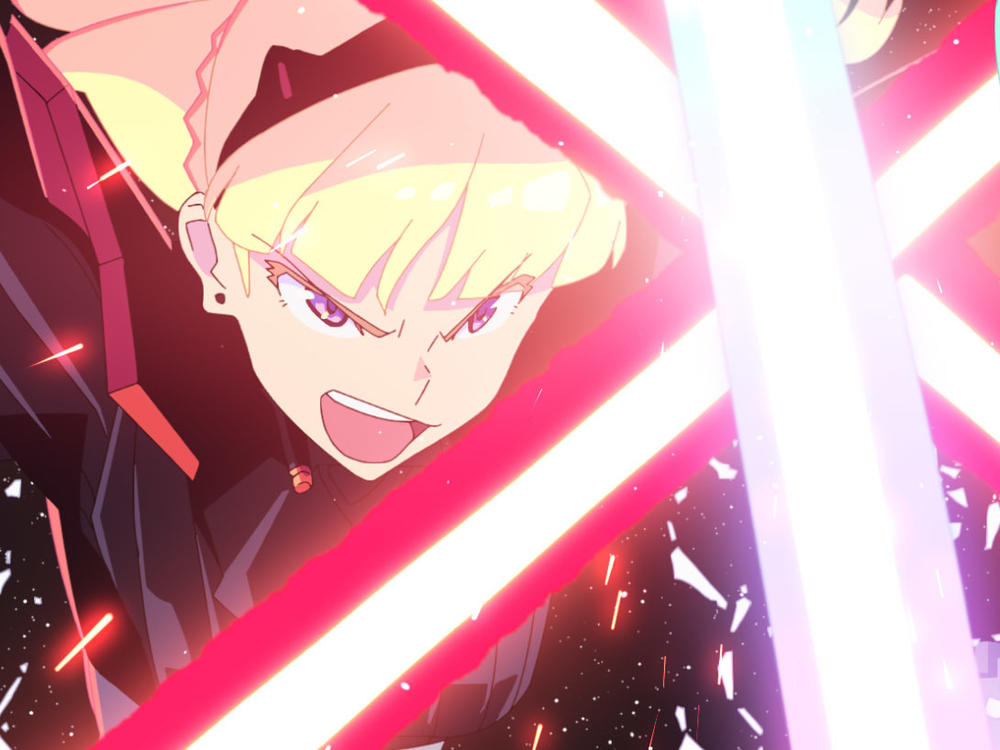Section Branding
Header Content
Anime Anthology 'Star Wars: Visions' Expands The Galaxy Far, Far Away
Primary Content
Let's get this out of the way: It's uneven.
There.
Any anthology series has episodes that work better than others. Star Wars: Visions is an anthology series; some of its episodes work better than others.
Which episodes work better for you will depend entirely on what you come to the Star Wars franchise for.
Is it the epic space battles? You won't find those here. These episodes tend to tell smaller stories set on various planets — including a few that will be all-too-familiar to fans of the franchise — so if you're a devotee of space-dogfights in space-trenches, look elsewhere.
Similarly, if you're a fan of Star Wars' penchant for charming rogues and daring rescues and narrow escapes — the swashbuckling derring-do that has its genesis in George Lucas' avowed love for movie serials — keep walking.
But if you're here for characters gravely intoning the hokiest of dialogue about "The Force" and "The Dark Side" and "Stretch Out With Your Feeeeeeelings" — aka, the Jedi Stuff — pull up a space-chair. This series is for you. (I count myself among this cohort, so it's ostensibly for me, too.)
There's a full-circle nature to the series: George Lucas has often talked about the Star Wars saga's debt to Akira Kurosowa films like The Seven Samurai and The Hidden Fortress.
Disney invited leading Japanese anime studios to tell Star Wars stories, and largely let them go to work without forcing them to adhere to the franchise's strict canonical timeline. This fact is responsible for the series' best aspects — its striking visuals, and its lack of references to specific characters and events in the established Star Wars saga.
First the visuals: It's bracing to see the familiar trappings of the Star Wars universe inflected through a different cultural aesthetic; each episode feels, appealingly, like it's merely riffing on Ralph McQuarrie's original Star Wars conceptual designs that have for so long been dutifully, endlessly reiterated through films, tv shows and comics.
It's more than turning lightsabers into lightkatanas and calling it a day. Each episode of Star Wars: Visions represents a fundamental and sweeping visual reimagining through an anime lens, whether that features painstakingly rendered landscapes, grim Ronin-esque Jedis, or a cute, Astro Boy-like droid who longs to learn the ways of the Force. From the architecture of isolated hamlets and forbidding palaces to the elastic expressiveness of characters' facial expressions, the series represents a fusion of influences with the potential to take the franchise in new directions ...
... visually, at least.
But even though the creators were given free rein, they remain saddled by Star Wars' strict and limited narrative conventions. Jedis are good, Sith are evil. They fight. Rather a lot. Lather, rinse, repeat.
One can be turned from one side to the other, sure — a couple episodes deal with this — but mostly, the vast Star Wars galaxy is black and white (or if we're talking lightsabers, red and blue), and if you come to it looking for anything more than tidy morality plays, you'll spend it wandering the Tatooine deserts until you get eaten by a krayt.
There's an argument to be made that by establishing characters outside the established timeline, yet having them enact very familiar, nay, achingly familiar conflicts, the series is gesturing towards some kind of universal cycle of Sith-Jedi clashes — a kind of Ragnarok or Yuga Cycle, only with robes and rat-tails. Maybe. The simpler answer, of course, is that the franchise's simplistic moral worldview is impossible to get out from under.
To be fair, animated Star Wars series like Rebels and The Clone Wars managed to find some shades of space-gray in the reductively Manichean Star Wars universe, but then, they each had several seasons to do so. Most episodes of Star Wars: Visions, on the other hand, clock in somewhere around the 20-minute mark.
Which points up another limitation of the series: Though marketed as a succession of discrete "animated short films," no episode feels dramatically complete. Instead, they resolve their immediate storylines and conclude by gesturing towards larger, unresolved conflicts — the villain escapes, a war begins, a mystery whose answer awaits our heroes somewhere out among the stars beckons.
The inevitable result, of course, is for each episode to feel like a carefully wrought and promising pitch for an ongoing series — just so many pilot episodes, elbowing each other for pickup.
Whether or not that's how it's intended, that's how it plays out. For the record, I'd be on board for series based on episodes 5 ("The Ninth Jedi"), 7 ("The Elder") or 9 ("Akakiri").
If you're prepared to approach the series as a testament to this venerable franchise's limitless visual potential but limited narrative potential (seriously, take a drink every time someone mentions kyber crystals), you'll set yourself up for getting out of it exactly what it's prepared to offer you, and nothing more.
Copyright 2021 NPR. To see more, visit https://www.npr.org.

